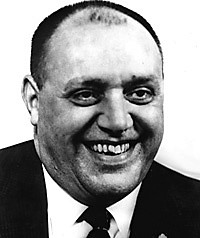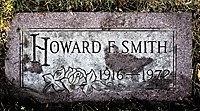Detective Howard F. Smith | Cincinnati Police Division

Badge: D12
Age: 55
Served: Almost 32 years
November 1, 1940 to September 13, 1972
OFFICER
Howard was born July 17, 1916 to Fred E. and Susie (Osborne) Smith. He attended Withrow High School, graduating in 1934. He then attended the Littleford-Nelson Business School until 1938.
Howard enlisted in the United States Army on March 31, 1941, was assigned to the Signal Corps and was trained as a radio operator. He was honorably discharged during January 1945, near the end of World War II, as a Second Lieutenant, and joined the Army Reserves.
Howard joined the Cincinnati Police Division as a Police Recruit on November 1, 1940. On February 1, 1941 he was promoted to Patrolman and assigned to District 7 (Walnut Hills). Twelve years later, on January 1, 1953 Patrolman Smith was transferred to the Highway Safety Bureau. Two years after that, on January 1, 1955, he was promoted to Detective and assigned to the Crime Bureau. During his first 30 years, Detective Smith had earned 32 letters of appreciation and/or commendation, seven from police chiefs.
To combat bank robberies in the early 1970s, the Cincinnati Robbery Squad Commander, Lieutenant James Daley, arranged with the 5th/3rd Bank to have plain-clothed police officers work off duty posing as tellers or bank managers. Detective Smith worked many of these details, most of which were at the nine riskiest branches, including the Mohawk Branch at 2026 Central Parkway.
INCIDENT
On December 20, 1971, at 10:08 a.m., Detective Smith was posing as a teller at the Mohawk Branch when two armed men, Raymond Sams (19) and Isaac Beasley (17), walked in wearing masks. Sams announced a holdup and then discharged a sawed-off over Detective Smith’s head and into a back wall. Detective Smith pulled his .38 Special revolver and returned fire but missed. Beasley, who Detective Smith probably had not seen, snuck behind the tellers’ cages and, with a .22 caliber pistol, shot Detective Smith in the back. The searing pain caused Detective Smith to collapse to his knees. Beasley walked up to him and shot him twice in the head. Sams and Beasley then fled the bank without any money.
When Cincinnati Police Communications Section broadcasted a call for assistance at the bank, Patrolmen Howard Nichols and Marty Kelly had been patrolling Findlay Market – very close to the bank – in a scout car and were the first officers to arrive at the bank. As they were climbing out of the car, Detective Smith walked out holding a towel to his head, got into the back seat and said, “I’m dead.”
Patrolman Nichols rushed him to Cincinnati General Hospital, arriving in about three minutes. During the short trip, Detective Smith uttered, “pain… like sounds.” Upon arrival, Detective Smith got out of the car and walked into the emergency room where medical personnel ushered him to a trauma bed.
Doctors performed emergency surgery, including a craniotomy, but chose not to remove two of the bullets; one in the brain and one near his spinal cord. He was admitted and would never leave the hospital.
INVESTIGATION
Sams and Beasley, meanwhile, drove a Buick Electra 225 from the 5th/3rd Bank straight to Detroit, Michigan where they tossed their firearms into the Detroit River.
The Robbery Squad conducted the investigation, including Lieutenant Daley, Detective Bluhm, and Specialists John Day, Wilson Day, Gus Feldman, Ed Heinzelman, and Robert Kramer. A bank camera showed the Buick in which the suspects fled, but not the license plate. A vagrant in the area saw the two and their car but could not initially help with the descriptions. Lieutenant Daley drove the witness to a Middletown hypnotist, and under hypnosis he was able to provide decent descriptions, including most of the license number.
In time, Sams and Beasley returned to Cincinnati and continued their lives in crime. It was not long before Beasley was caught in one or more felonies, adjudicated in Juvenile Court, and sent to the Mansfield Reformatory.
Sams was arrested by Police Officer Daniel Steers after a botched holdup of a pony keg in Carthage. As was the procedure in that era, Officer Steers did not immediately charge Sams, but held him for Investigative Detention. This allowed Criminal Investigation personnel to interview recently arrested felons in the hopes of discovering other offenses committed by them and/or their associates. Sams was already known as a man who, during the 1967 race riots, fired a handgun into a Cincinnati Firehouse. Criminal Investigation Section personnel thought he was a good fit for the Detective Smith shooting. Specialists Heinzelman and Feldman interrogated Sams. He confessed and implicated Beasley.
Specialists Heinzelman and Feldman traveled to Mansfield Reformatory and interrogated Beasley. Beasley staunchly denied any involvement in the shooting; even when confronted with Sams’ confession. Finally, the Specialists brought Sams into the interview room and Beasley confessed.
DEATH

Detective Smith remained in critical condition for 8¾ months. He underwent several surgical procedures and deteriorated gradually, never regaining more than a semi-conscious state. He finally expired, emaciated and wasted, on September 13, 1972 at 3:30 a.m.
Detective Smith left a wife, Frances (Leeds) Smith, and two children, Michael Burroughs (23) and Alanna Burroughs (21). He was buried in Section 135, Lot 257, Grave 9 of Spring Grove Cemetery. Frances joined him 28 years later on December 31, 1999.
JUSTICE
Raymond Sams was convicted of 1st Degree Murder with a jury recommendation for mercy. Judge William B. Mathews sentenced him to life imprisonment for killing Detective Smith and twenty years for the bank robbery. The terms were to run consecutively so that, if at some point he was paroled on the murder, he would still have twenty years to serve on the robbery. The Parole Board, instead, held a hearing without notifying family or law enforcement and paroled Sams during September 2002. He was last known to reside at 674 Glenwood before it was repossessed in January 2012.
Isaac Beasley was also convicted of 1st Degree Murder. The Parole Board, without notifying family or law enforcement, held a parole hearing and paroled him during June 2002. During 2006, he was arrested again and indicted on five counts of Forgery, Theft, and Unauthorized Use of Property. He plead to two counts, received a short sentence of ten months incarceration, and his parole restrictions were extended. For unknown reasons, he was not sent back to the penitentiary. He was fully released in 2011. He was last known also to reside 3963 Ardmore Avenue in Avondale, though it was repossessed in 2010.
If you know of information, artifacts, archives, or images regarding this officer or incident, please contact the Greater Cincinnati Police Museum at Memorial@Police-Museum.org.
This narrative was revised December 17, 2014 by Cincinnati Police Lieutenant Stephen R. Kramer (Retired), Greater Cincinnati Police Historical Society President, with anecdotal input from Cincinnati Police Lieutenant Joseph W. Hall, Specialist Gus Feldman, and Police Officers Howard Nichols and Thomas McAlpin (all retired). All rights are reserved to them and the Greater Cincinnati Police Historical Society.